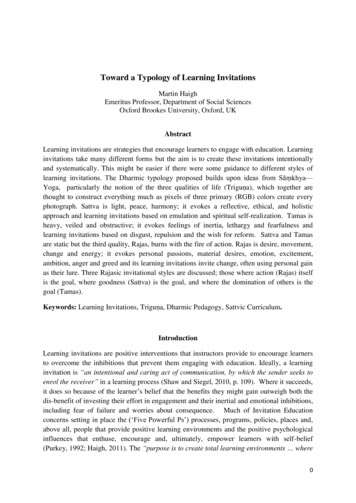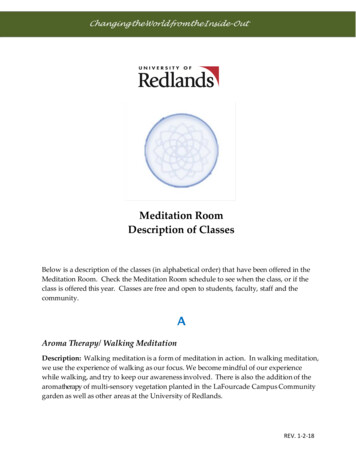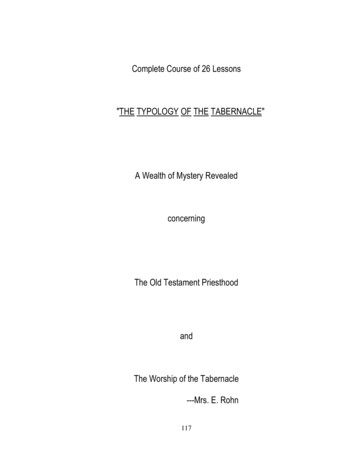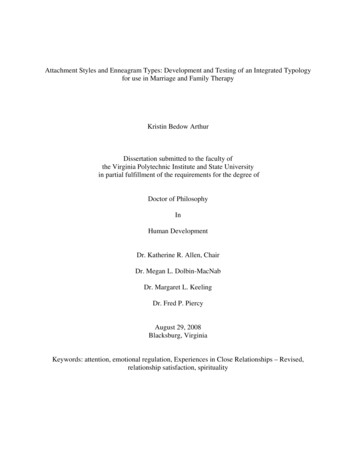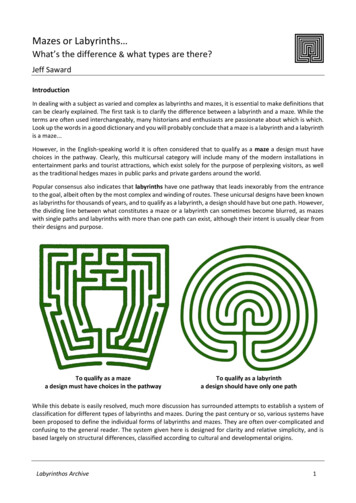
Transcription
Mazes or Labyrinths What’s the difference & what types are there?Jeff SawardIntroductionIn dealing with a subject as varied and complex as labyrinths and mazes, it is essential to make definitions thatcan be clearly explained. The first task is to clarify the difference between a labyrinth and a maze. While theterms are often used interchangeably, many historians and enthusiasts are passionate about which is which.Look up the words in a good dictionary and you will probably conclude that a maze is a labyrinth and a labyrinthis a maze.However, in the English-speaking world it is often considered that to qualify as a maze a design must havechoices in the pathway. Clearly, this multicursal category will include many of the modern installations inentertainment parks and tourist attractions, which exist solely for the purpose of perplexing visitors, as wellas the traditional hedges mazes in public parks and private gardens around the world.Popular consensus also indicates that labyrinths have one pathway that leads inexorably from the entranceto the goal, albeit often by the most complex and winding of routes. These unicursal designs have been knownas labyrinths for thousands of years, and to qualify as a labyrinth, a design should have but one path. However,the dividing line between what constitutes a maze or a labyrinth can sometimes become blurred, as mazeswith single paths and labyrinths with more than one path can exist, although their intent is usually clear fromtheir designs and purpose.To qualify as a mazea design must have choices in the pathwayTo qualify as a labyrintha design should have only one pathWhile this debate is easily resolved, much more discussion has surrounded attempts to establish a system ofclassification for different types of labyrinths and mazes. During the past century or so, various systems havebeen proposed to define the individual forms of labyrinths and mazes. They are often over-complicated andconfusing to the general reader. The system given here is designed for clarity and relative simplicity, and isbased largely on structural differences, classified according to cultural and developmental origins.Labyrinthos Archive1
Classification of Labyrinths - The Major CategoriesThe earliest labyrinth symbols so far discovered are all of the same simple design - the “Classical” type - whichis found worldwide and remain popular to this day. During this 4000 year history, the Classical labyrinth hasdeveloped into a number of closely related forms, often in particular geographical regions, by means of simpleadjustments to the "seed pattern" that lies at the heart of its construction.However, from time to time, major developments have taken place, resulting in quite different types oflabyrinths being created, which have then themselves been further developed. This process continues to thisday, indeed, since the 1980s several radically new types of labyrinth designs have been created and these willundoubtedly continue to flourish and develop in the future.To bring some sense of order to this multitude of seemingly different labyrinth designs, I would propose thatlabyrinths can be classified into four major categories, although all of these have various sub-categories, whichcan be further sub-divided if one so wishes. These major categories can be classified as Classical, Roman,Medieval and Contemporary labyrinths:Classical LabyrinthsRoman LabyrinthsDating back to at least 2000 BCE, and foundworldwide, these are by far the oldest and mostwidespread type of labyrinth.First developed in the 2nd century BCE, they arefound throughout Europe and North Africa,wherever the Romans settled.Medieval LabyrinthsContemporary LabyrinthsFirst developed in 9th/10th century Europe, theysoon spread throughout Europe and have becomeespecially popular in modern times.First developed in the late 20th century, this rapidlyevolving group often have unusual designs, but areclearly labyrinths by intention.Labyrinthos Archive2
The Classical LabyrinthThe archetypal classical labyrinth designconsists of a single pathway that loops back andforth to form seven circuits, bounded by eightwalls, surrounding the central goal. It is foundin both circular and square forms. Practically alllabyrinths prior to the first few centuries BCEare of this type. Found in historical contextsthroughout Europe, North Africa, the Indiansub-continent and Indonesia, this is also thedesign that occurs in the American Southwestand occasionally in South America. During thecurrent revival of labyrinths it has once againfound popularity for its simplicity ofconstruction and archetypal symbolism.Wherever it is found, the same method ofconstruction is commonly encountered - the socalled ‘seed-pattern,’ shown opposite. Thissimple technique for remembering the processof drawing the classical labyrinth hasundoubtedly been instrumental in itswidespread occurrence and popularity.This form is also (inappropriately) known as the "Cretan" labyrinth, a term that implies an origin on the islandof Crete. Although its association with the legendary Labyrinth at Knossos is well documented, the designcertainly predates the legend and has not been found on Crete prior to the fourth century BCE. It is also knownas the "seven-circuit labyrinth," but this too is confusing, for other labyrinth types can have seven paths andclassical labyrinths may have more, or less, than seven circuits. The term "Classical" has gained widespreadacceptance in recent years and is to be preferred, as it correctly implies the original form and is free fromassociation with any particular location or region - appropriate for a design that is found worldwide.Labyrinth petroglyph, Mogor,Galicia, Spain, c. 2000 BCE, one ofthe earliest known examplesCircular and square varieties of theclassical design and mirror images,with the first pathway turning leftor right, are common varietiesA classical labyrinth with 15 paths(16 walls), painted on the wall ofRoerslev Church, DenmarkThe simplicity of its construction from an easily remembered seed pattern has clearly been instrumental in thewide cultural dissemination of the classical labyrinth design. It is by far the world's most common andwidespread form, and remains popular to this day. Simple amendments to the seed pattern allow differentversions of this form to be created quickly and easily and such varieties, often with eleven or fifteen circuits,are common in historical contexts in Europe, especially in Scandinavia. Several important variants used inhistorical contexts are distinctive enough to deserve sub-categories of their own.Labyrinthos Archive3
Classical VariantsBaltic typeFound throughout Scandinavia and also in northern Germany, but principallyaround the shorelines of the Baltic Sea, this labyrinth is also known as the"Baltic Wheel" or "Wheel," after an important example in Hanover, Germany.A relatively simple reconnection of the upper part of the classical seed patternproduces a double spiral at the centre with separate entrance and exit paths.These labyrinths are ideal for continuous processions and games where two ormore walkers enter the labyrinth, and this purpose is often reflected inassociated traditions and folklore.A Baltic type labyrinth cut in turf at Dransfeld, Germany (now destroyed).The double spiral at the centre allows a quick exit from the labyrinthChakra-vyuha typeAn unusual development of the classical labyrinth, found primarily in India, isbased on a three-fold, rather than four-fold seed pattern and is consequentlydrawn with a spiral at the centre. It is referred to in Indian tradition as “Chakravyuha,” a name derived from a magical troop formation employed by themagician Drona at the battle of Kurukshetra, as recounted in the Mahabharataepic.The stone labyrinth at Baire Gauni, Tamil Nadu, India,laid out in the Chakra-vyuha style encountered throughout IndiaMan in the MazeThis distinctive variety of the classical labyrinth is found in the AmericanSouthwest, especially on the basketry, jewellery and other craftworkproduced by various Native American tribes in the states of Arizona andNew Mexico. First developed around 1915, it remains popular and hasbecome a symbol of tribal identity for several communities in Arizona.Man in the Maze labyrinth on a basket createdby a Tohono O’odham weaver from Arizona, USAOther Classical Seed PatternsOther labyrinths based on three-fold and occasionally on two-fold or five-fold seed patterns are found invarious locations. A unique five-fold classical labyrinth with nine circuits recently discovered on a Pima basketfrom Arizona demonstrates the many varieties of labyrinth that can be created with a full understanding ofthe construction process. A number of labyrinths with curious designs, obviously based on the classical form,or incorrectly drawn by unskilled hands, should also be included in this category.A Pima basket, made c.1920, with an unusualnine-path variant of the “Man in the Maze”classical variant, created from a five-fold seedAn unusual seed pattern from India,used for a ritual to ease the pain of childbirthLabyrinthos Archive4
Other Classical Seed PatternsLabyrinths drawn with non-standard seed connections will often result in unusual designs. Occasionally thesemight appear to be deliberate design choices, other times simply happy accidents.Wall fresco,Seljord, NorwayRock-carved inscription,Stora Anrås, SwedenBoth labyrinths have onequadrant completed as aspiral, resulting in a curious‘entrance’ to their designsThe Otfrid LabyrinthAn important classical labyrinth variety, the Otfrid is based on the classical seedpattern, but is drawn concentrically with an additional set of turns added tocreate an eleven-circuit labyrinth. Popular in Christian manuscripts from themid-ninth century CE onwards, it probably provided the impetus for thedevelopment of the much more influential medieval design and also occurs as17th century pebble mosaics in churches in NE Spain.Otfrid labyrinth design, with battle between Theseus and the Minotaur, late 12thcentury manuscript, Regensburg, Germany (photo: Bayerische Staatsbibliothek)Swastika LabyrinthsAn unusual and evidently ancient labyrinth variety, swastika labyrinths are seemingly unrelated to any otherform, and are found throughout India, as far north as Nepal, and occasionally elsewhere in Southeast Asia.They frequently appear as a decorative element on temples, Hindu, Buddhist, Sikh and Muslim, and can alsobe found as graffiti. Currently under researched, they are easily overlooked, but their use in connection withvarious labyrinthine stories and legends in India marks them as a legitimate labyrinth variety. As with otherlabyrinth designs, there are various developments of the basic form, but all share common design elements.Swastika LabyrinthsTemple ceilingdecoration,Bijapur, IndiaCarved woodenprinting block,Jaipur, IndiaLabyrinthos Archive5
Roman LabyrinthsWhile the classical labyrinth was known throughout the Roman Empire, the popular use of the labyrinth as adesign element in mosaic flooring resulted in a number of developments, all conveniently classifiable as“Roman” varieties. While rarely encountered amongst the examples created since these times, theselabyrinths are of considerable interest, as they represent the first real attempts to create different forms ofthe genre and the first major changes to a symbol that had already been in circulation for some two thousandyears. Researchers have attempted various classifications of these Roman designs, usually based onmathematical or geometrical properties, but basically the majority of the sixty or so Roman mosaic labyrinthsdocumented or preserved can be designated as meander, serpentine, or spiral types, with just a few complexdesigns falling outside of this simple ous variations on these basic design types are encountered, with more or less circuits, single or multiplegroups of meanders or turns, and more or less than four axis of symmetry. They were also created in a numberof shapes, square and rectangular, circular, polygonal, etc., and date from the middle of the 2nd century BCEuntil the 4th century CE.A simple serpentine-type mosaic,Paphos, CyprusA typical meander type mosaic,Cremona, ItalyLabyrinthos ArchiveComplex Roman mosaic design, with a continuous single pathleading to the centre, and back out by a different route, Pula, Croatia6
The Medieval LabyrinthFirst developed in Christian manuscripts in Europe during the ninth andtenth centuries CE, the medieval labyrinth has obvious four-fold symmetry(also often seen in the Roman labyrinths) to produce a design far bettersuited for use in a Christian context. While commonly created with 11concentric circuits surrounding the central goal, a number of early examplescan be found with anywhere between 5 and 15 circuits and with slightlydifferent path connections and arrangements.6-circuitmedieval labyrinth design, in a manuscript created at Abingdon,England, c.1030-1048 (photo: Cambridge University Library)11-circuit form, Lucca Cathedral,Italy, early 12th centuryDifferent path arrangement, SensCathedral, France, late 12th century5-circuit form, Compiègne, France,17th centuryBy the eleventh and twelfth centuries this form became common in manuscripts and in the decoration ofchurch walls and floors in Italy. By the early thirteenth century it had spread to France, and soon became theprinciple form throughout southern and western Europe. The famous use of this labyrinth at ChartresCathedral has led many writers to term this design the "Chartres" labyrinth. For exact replicas of the labyrinthat Chartres, this term is acceptable, although inappropriate otherwise, as this design was in widespreadcirculation long before it was employed at Chartres. Likewise, “cathedral” and “eleven path/circuit” are namesthat do not accurately reflect the variety of designs and locations in which this design is encountered. Althoughothers have used the term "Medieval Christian," "Medieval" accurately portrays the context of this labyrinth,and does not exclude those examples that appear in secular or non-Christian contexts.An ornate form, Chartres Cathedral,France, c. 1215-1220Labyrinthos ArchiveVarious shape varieties: woodenlectern, Volterra, Italy, 15th centuryLeft and right-handed versions areknown: Arras, France, 13th century7
Medieval VariantsAs with the classical labyrinth, a considerable number of variations upon the basic theme of the medievallabyrinth have been recorded. Circular, square, and polygonal forms of the basic medieval form are commonand need no separate classification. However, some examples display deliberate attempts to produce adifferent design - with more or fewer circuits, different methods ofconnecting the pathways, or alterations to fit the space available orpurpose intended. Some, such as the labyrinth formerly in ReimsCathedral, France, were especially influential. With the invention ofprinting in late 15th century, specific labyrinth designs appearing in earlyarchitecture and gardening books were widely copied and adaptedfurther. Other variations are clearly the result of incorrect attempts atconstruction or inaccurate restorations of previous designs; this isespecially the case with labyrinths formed from turf or boulders, whichare prone to deterioration and disturbance.The pavement labyrinth formerly at Reims Cathedral, France, a medievaldesign with various changes to the circuit connections and corner bastionsThis labyrinth design from Serlio’sarchitectural design book of 1537was used for the construction of anumber of labyrinths across Europeduring the 16th centuryThe design of the turf labyrinth atSneinton, England shows severalpath connection ‘errors,’ resulting ina choice of paths and no centralgoal as suchThe turf labyrinth formerly atBoughton Green, England, had amedieval design with variouschanges to the circuits and thecentre replaced by a spiralThe current revival of interest in the medieval labyrinth design, especially in America since the mid-1990s, hasresulted in the development of a number of new variations. Some are based directly on the labyrinth inChartres Cathedral, often with fewer circuits to enable them to fit in confined spaces, or to produce widerpaths. A number have been given specific names by their creators, but as most of these titles exist primarilyto establish copyright, they can conveniently be included in this sub-category of the medieval type.St. Omer typeOne particular medieval group probably deserves separate recognition the St. Omer labyrinth. Although its pathway may seem to be a randommeandering design, it can be demonstrated that the pattern wasdeveloped directly from the standard medieval form. The originalexample constructed in the fourteenth century at the Abbey of St. Bertinin St. Omer, northern France, was subsequently copied and furtherdeveloped and has been employed on various occasions until recenttimes.The pavement labyrinth formerly in the Abbey of St. Bertin, FranceLabyrinthos Archive8
Contemporary LabyrinthsThe current revival of interest in labyrinths has resulted in anumber of designers and builders consciously stretching theboundaries of what constitutes a labyrinth, or deliberatelyseeking new forms for new purposes. Ranging from theminimalist, with just a few turns and paths to capture theessence of the labyrinth, to complex symbolic and thematicdesigns, they still retain a single pathway, leading sometimesto a centre, but other times around the full course of thedesign and back outThe “Snoopy Labyrinth,” designed by Lea Goode-Harris,Charles M. Schultz Museum, Santa Rosa, California, USAThe modern stone labyrinth at Folhammar, Gotland, Sweden, isinspired by traditional forms, but consists of numerous meanders andspirals, forming one long pathway covering an extensive areaAlex Champion's "Viking Age HorseTrappings Maze," a complex swirlingdesign with one continuous pathwayThe twin path “Trojan Ride” labyrinth createdby Jeff Saward at New Harmony, Indiana, USAin 2010, specifically designed to be ridden by atroop of horsesAlso included here are the Reflection and Relationship labyrinths thathave become popular in recent years, which despite having more thanone pathway are still labyrinths by intent. Undoubtedly, some of thesemodern varieties may go on to be judged as important separatedevelopments when studied in the future, but for now this proliferationof forms can best be compared and contrasted within the"Contemporary" heading.The dual-path “Heart Labyrinth,” by Marty Kermeen & Jeff Saward, has twopaths leading to the centre, linking to each other to return to the entrance.While technically multicursal, it is a labyrinth by intentLabyrinthos Archive9
MazesWith a history stretching back to the late Middle Ages, puzzle mazes, like labyrinths, were simple at first, thenunderwent periods of rapid development. Developed initially from medieval labyrinth designs, the earliestmazes in the gardens and palaces of Europe were designed by rearranging the walls of a labyrinth to create apathway with choices; often including a number of dead-ends.While various types of mazes have been proposed and described by modern authorities, five basic types canbe clearly identified, as described below. It should be noted, however, that the ingenuity of modern-daydesigners often results in mazes that can fit happily in more than one of these categories, and, indeed, a fewthat are difficult to fit into any type. A conundrum that would surely have pleased Daedalus himself!Simply-connected MazesThe majority of early mazes, however complex their design may appear,were essentially formed from one continuous wall with many junctionsand branches. If the wall surrounding the goal of a maze is connected tothe perimeter of the maze at the entrance, the maze can always besolved by keeping one hand in contact with the wall, however manydetours that may involve. These ‘simple’ mazes are therefore correctlyknown as "Simply-connected."A simply connected maze design with limited choice of paths,planted at Krenkerup, Denmark, in 1877Mutiply-connected MazesIt was not until the early nineteenth century that the principle of isolatingthe goal of the maze from the perimeter to defeat the "hand-on-wall"method and increase the level of difficulty was truly understood. Anymaze with the goal set within an island of barriers, physicallyunconnected to the rest of the maze, qualifies as "Multiply-connected."The best examples contain islands within islands and, paradoxically, canbe developed into very intricate mazes with very few dead-ends that arenonetheless extremely difficult to solve.The hedge maze at Chevening House, England, c.1820, one of the firstconsciously designed to provide a more complex puzzle and thwart the"hand-on-wall" rule for solving mazesThree-dimensional MazesAlthough the majority of traditional mazes with walls of hedges or other materials may appear threedimensional, the pathway through the maze is essentially only two-dimensional. While the concept of trulythree-dimensional mazes has been around since the nineteenth century, they existed only on paper until theearly 1980s, with the introduction of bridges and underpasses to add complexity to the panel mazes thenpopular in New Zealand, Australia and Japan. Bridges are also a common addition to the huge cornfield, ormaize mazes that have become popular worldwide since the mid1990s. The introduction of the third dimension allows the islands ofa multiply-connected maze to be totally isolated from each other,with the only link via a bridge. In some of these mazes, successfulprogress to the goal depends on reaching a series of points withinthe maze in the correct order.A wooden panel maze at Labyrinthia, Rodelund, Denmark.With bridges and underpasses, it is typical of the newgeneration of three-dimensional mazes (photo: Ole Jensen)Labyrinthos Archive10
Conditional Movement MazesLong established as a theoretical concept, mazes with rules, or "ConditionalMovement Mazes," have become a reality since the 1980s. The next move isdictated by the overall rules or by instructions given at the visitor's current position,allowing extremely complex puzzles to occupy a very limited space. Constructed inmodern materials and not always aesthetically pleasing, these mazes offer anentertaining intellectual challenge and have proved popular in educationalcontexts, particularly to illustrate mathematical and scientific concepts.The object of Steve Ryan's "Freeway Maze" is to enter the intersection and exiton the opposite return carriageway without making any U-turns and avoidingthe stalled cars (red spots) blocking a number of routes ( Steve Ryan)Interactive MazesHigh-tech mazes where the design responds to the actions of visitorsare an increasingly common feature at amusement parks and othertourist attractions. They incorporate computer-timed barriers andother innovative devices such as motion sensors and mechanismsthat determine the physical characteristics of the walker. Interactivemazes first appeared in the closing years of the twentieth centuryand undoubtedly herald the direction of future leading-edge mazedesign in the twenty-first century.A modern maze with interactive features at Drielandenpuntnear Vaals in the Netherlands, designed by and Adrian Fisher 1991Jeff Saward, Thundersley, England; March 2017Please note: The text and illustrations in this article are Jeff Saward 2017 (unless stated otherwise), adaptedand reproduced from Jeff's study of historical labyrinths and mazes, published in the UK as Labyrinths & Mazes- The Definitive Guide to Ancient & Modern Traditions by Gaia Books, London, 2003 (ISBN 1-85675-183-X); inthe USA by Lark Books, New York, 2003 as Labyrinths & Mazes - A Complete Guide to Magical Paths of theWorld (ISBN 1-57990-539-0), in Germany as Das Große Buch der Labyrinthe und Irrgärten (ISBN 3-85502-9210) by AT Verlag, Aarau & Munich, 2003 and in Russia as ЛБИРИНТЫ (ISBN 5-322-00291-X) by Ниопа 21-й век,Moscow, 2005.While you are welcome to print out copies of this article for personal use and educational purposes,commercial reproduction of this article and its illustrations is prohibited without specific permission.Visit www.labyrinthos.net for detailsLabyrinthos Archive11
A Baltic type labyrinth cut in turf at Dransfeld, Germany (now destroyed). The double spiral at the centre allows a quick exit from the labyrinth Chakra-vyuha type An unusual development of the classical labyrinth, found primarily in India, is based on a three-fold, rather than four-fold seed pattern and is consequently

